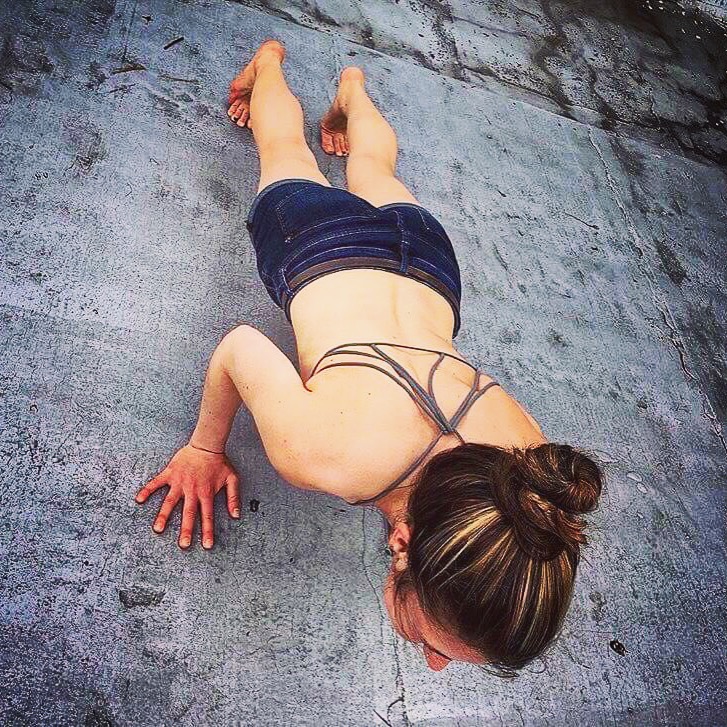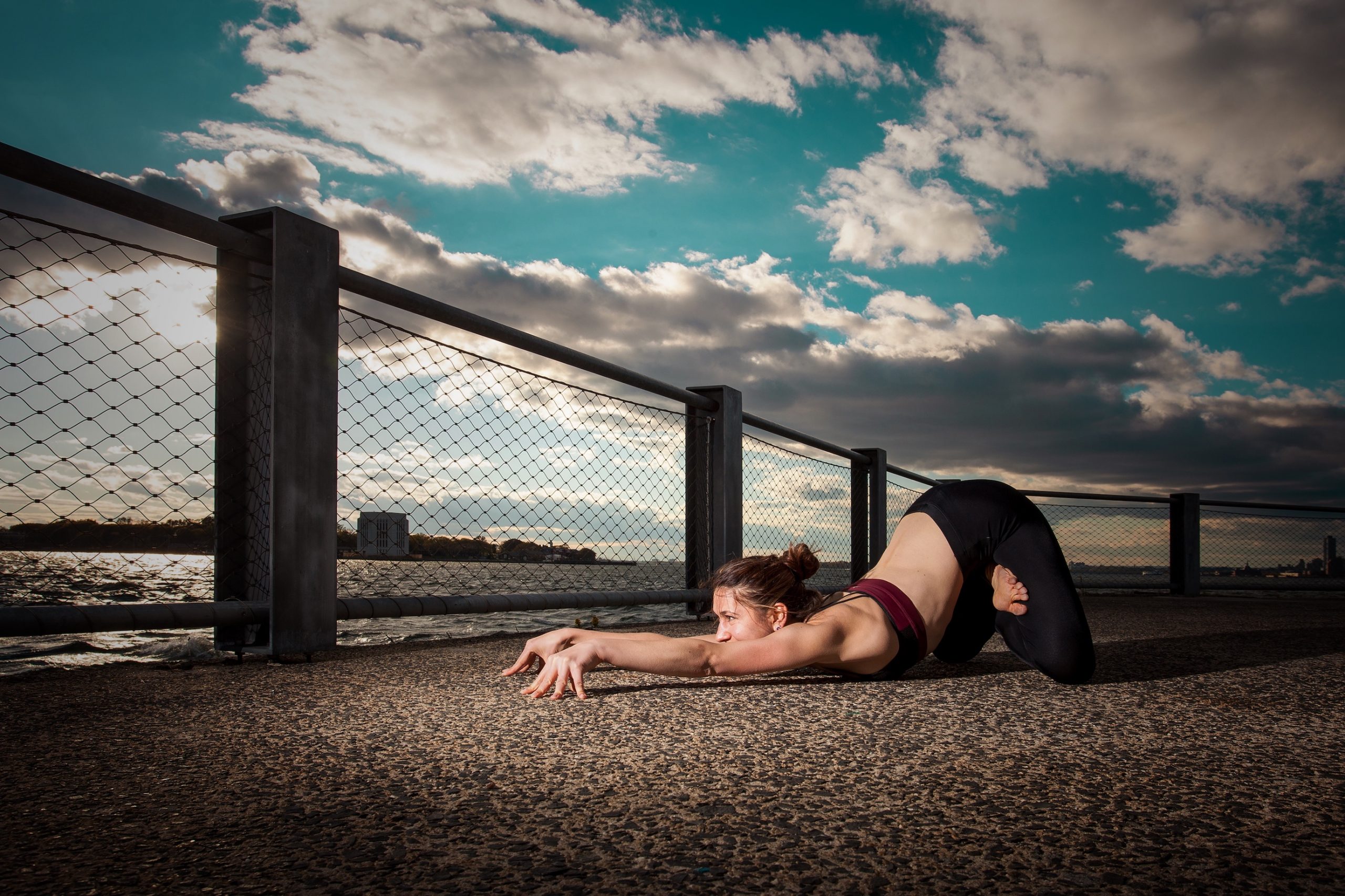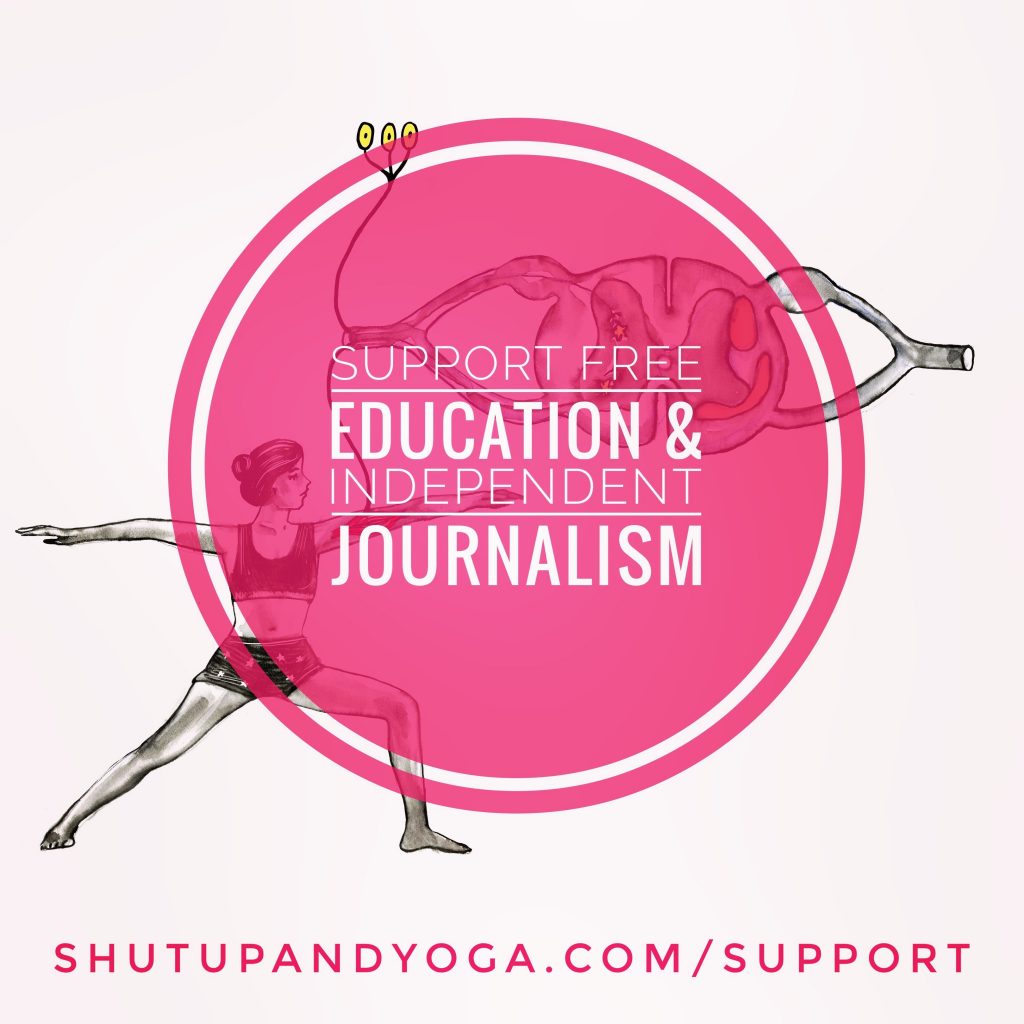Massachusetts native Giulia Pline — Boston Conservatory of Dance Alum, teacher at Kula Yoga Project, and a PhysiYoga Global Professional—was all about facing fears and rising up to challenges. A horrific accident in January 2017 would become the greatest test of her young life, leading her to prove that “what doesn’t kill you makes you stronger” is much more than lip service.
“I had started skiing in December 2016,” she explains. “I had taken maybe like six or seven lessons. The following month I was visiting one of my friends in the Berkshires. The mountains aren’t very high in Massachusetts, but it was very icy that weekend — kids were being pulled out of ski school. However, I decided I was going to go skiing anyway.”
She went up to one of the easy Green trails, started downhill and quickly picked up speed. “There was a little curve turn out of the last part of the trail and I couldn’t catch the edge of the ski.”
She slid out into the embankment and slammed into a tree.
“The initial impact felt like the wind got knocked out of me,” says Giulia. “Which is actually true because my lung had collapsed. I looked to my right side and I couldn’t feel my arm; I couldn’t feel the connection to my shoulder. It was like an out of body experience.”
The pain was so intense that Giulia went into shock.
“I broke six ribs, my upper arm and my collarbone; lacerated my liver and punctured my lung. The ambulance ride was 25 minutes, but it felt like the longest ride of my life.”
She was in the ICU for three days.
“They put a chest tube in so that they could fix my collarbone and my upper arm. They operated the next day, and put in plates and screws in the collarbone and upper arm.”
But the situation quickly proved even more dire:
“They took the first chest tube out, and when I had a CAT scan they saw that my lungs were still filled with fluid,” she says. “It wasn’t healing on its own. The ribs that had broken inward and punctured the lung were so badly displaced that they were chafing against the lung. A cardiothoracic surgeon came in to do a second surgery. He ended up plating three of my ribs. He had to cut through all the muscle, and then they gave me a second chest tube to drain the excess fluid to the lung.”
A yogi to the core, Giulia’s feelings quickly turned to gratitude. “Thank god I didn’t hit my spine or brain,” I thought. “I’ve been injured before, but this was so intense. I said to myself, ‘I survived it. I’m going to be fine’.”
Unable to type with her right hand, Giulia could only alert her family and friends in a single Facebook post from her hospital bed. With wisdom and resolve, she observed that “The true yoga is patience, hope, and faith.”

“The initial part that yoga played was right there in the hospital,” she says. Because I have so much experience in yoga and meditation, I know how to center myself. Through my practice and focusing on my breath. You’d never realize how much it comes in handy when you’re in excruciating pain, and you have to breathe. And I didn’t even have a proper lung to breathe out of! It’s mind-body connection. If I went down the rabbit-hole of despair in my mind, it would have made it so much worse and I wouldn’t be able to stand it. I had no choice but to say, ‘yes I have physical injuries, but I will center myself and focus on my breath, and connect to something else. It’s everything. It pulled me, and my family, out of the hole.”
Eleven days later, she was finally discharged. But life was far from easy, and wouldn’t be for some time. “It was a struggle to be a normal person,” she explains. “I couldn’t sit up in a chair because of the fractured ribs. Whether you sneeze, cough, laugh—everything you do gives you pain. I couldn’t sleep flat for three months; couldn’t roll to my right side until six weeks ago. I still had a partially collapsed lung, because they had to take the chest tube out, it was in for too long.”
Giulia was given an inspirometer to work on reinflating the lung. “At first I could only get the ball inside to go up two inches.”
At the time of her release, no one could give her a timeline for how long her recovery would take. “They said, ‘maybe you’ll get this amount of range of motion at this period of time, or maybe you won’t. Maybe you’ll still be on the medication in six months, maybe not.”
She would invariably be waved off with a “You’re young, you’ll heal.”
“But that meant nothing to me, because I was in pain and didn’t know what was going to happen,” she says.
Giulia was aware that her career and livelihood as a freelance yoga teacher might be compromised:
“The next thing that went through my mind was, ‘How am I going to support myself if I can’t work for three months?” she says. “I’m a freelancer, and I’m not covered by the yoga studios I work at. And private clients come and go.”
Giulia had no guarantee her clients and classes would be there when she recovered; if she would be back to full capability anytime soon, or even if she’d want to be a yoga teacher anymore. It was the teacher’s nightmare scenario come true.
“I broke my leg dancing when I first moved to New York,” she explains. “And that was how I transitioned out of professional dance to teaching yoga. I was doing yoga to rehabilitate— working down dog with my ankles; strengthening my legs with standing poses; understanding the symmetry between right and left; holding poses, looking at my body and how it works.”
Giulia was moved to immerse herself in asana. “I did therapeutic training, and other certifications that included heavier anatomy and alignment sections. I just loved it so much that I transitioned out of dance, and decided this is what I want to do.”
Remembering how her love of dance had faded, Giulia braced herself for another life change.
“I wondered how I was going to feel when I went back to teaching,” she says. “Am I going to be disconnected, and want to transition out of yoga? When I went back to dance, I didn’t want to do it anymore. I was different.”
Facing the unknown, Giulia returned to a modified mat practice within a few months. “When I started again, I couldn’t weight bear, but I could do my standing poses,” she says. “There’s nothing better than just doing something like tree pose, connecting with my breath again and moving my body.”
By May she had run a 5k, and by June was back doing handstands. And now she can inhale the inspirometer ball all the way to the top. “It’s incredible how the body heals,” she smiles.

Her shoulder in a sling, she returned to Kula to teach. “I was really nervous, because I didn’t know how I was going to handle it,” she says. “But I walked into the room, and right away I knew, ‘this is what I’m meant to do.”
Giulia found that her love of teaching and connection was never stronger. “I love being around people, helping people; the environment, the energy of the practice,” she says. “All these people in the same room, moving and breathing together. We’re all working through some shit, whether it’s physical or emotional.”
Giulia was instantly aware that rather than being set back by her accident, she had far more knowledge to draw on and tools at her disposal.
“All teachers are doing the best they can with what they know,” she says. “What they’ve been given and experienced. But if you have a teacher that hasn’t had any injuries, and is hyper-flexible, they may not understand that someone isn’t doing a full wheel might actually have a back problem. Alison West grew a whole studio around a back injury she sustained! Most of the teachers there have dealt with some kind of issue. It makes them able to really understand. What I love about yoga is it can be modified a thousand different ways. Whether it’s with a chair, a wall, a rope or a block, you still have access to a certain stretch. You have to be a little creative, but it can be done. That opened my eyes.”
Giulia recognizes and is grateful for the wisdom that her experience has afforded her.
“It made me realize that not everyone has to have the ‘ideal look’ for the pose — have their arms straight, etc. That’s not what it’s about. Are they in it in a way that feels good for them? Can they breathe in the posture? Are they connecting with their body? That’s what the practice is about. And that’s what the injury impressed upon my teaching, and on myself.
There’s no ‘ideal’ anything.
It’s how you feel, and how you can become more integrated spiritually, physically and emotionally. And how you can use it to help you heal.”
Self-actualized by her experiences, Giulia has a renewed purpose as a teacher: to help other students who have been physically and/or emotionally compromised, to find their way back to the mat.
“What I am finding helpful in my own recovery, and as I come back into my own practice, is to meet myself with compassion, where I am,” she explains. “This is the work. While in the thick of my injury, I created a whole new practice in my exploration of the non-asana limbs. Breath and meditation provided me deep awareness and healing to my numbness and my disconnection…They set the tone for not only healing, but also neutrality, and a positive relationship with ourselves—exactly as we are.”

Giulia advises an exploration of slower, deeper, breath and silently speaking to the body during practice.
“Tell yourself you are safe,” she says. “Trust in your body’s ability to support and heal you. Create space for yourself to plant roots in stillness, patience, and easefulness in the body, mind and nervous system.
When you begin to connect with your ability to listen and to discern, start mindfully with what you know does not cause pain.
She recommends setting an intention to create a more subtle practice:
“Observe all that arises. From there, play to your edge with both ahimsa (non-harming) and satya (truth) toward your injury, body, and mind. Become invested in how stable, steady, and alive you can feel and become. Let yourself be inspired by any little piece of progress.”
Giulia has tips for time off the mat as well, when the mind is even more likely to go down the rabbit hole of distress.
“It is helping me to keep a journal of my journey,” she notes. “Days when I am discouraged and frustrated, I look back one week, six weeks, 12 weeks and remember how far I’ve come. Remember that the practice is broad and all-encompassing. The physical asana is only one portion of the true ‘yoking’ or ‘union’ that is yoga. Your recovering physical body is only one portion of the true ‘yoking’ or ‘union’ of you.”




